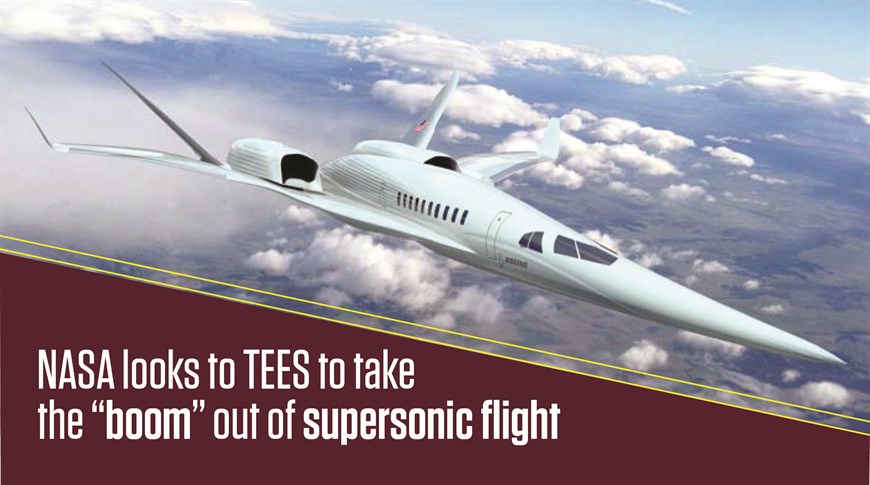 A team of Texas A&M Engineering Experiment Station (TEES) researchers has been selected for a potential award by NASA to lead research into commercially viable civil supersonic transport aircraft that meet noise and efficiency requirements for overland flight. Put simply, their research is on designing an aircraft that can modify its shape in real time in order to optimize for fuel efficiency or quiet flight as the flight phase and conditions change. The team is one of five transformative system-level aviation innovations that NASA has selected as part of the NASA Aeronautics’ University Leadership Initiative (ULI.)
A team of Texas A&M Engineering Experiment Station (TEES) researchers has been selected for a potential award by NASA to lead research into commercially viable civil supersonic transport aircraft that meet noise and efficiency requirements for overland flight. Put simply, their research is on designing an aircraft that can modify its shape in real time in order to optimize for fuel efficiency or quiet flight as the flight phase and conditions change. The team is one of five transformative system-level aviation innovations that NASA has selected as part of the NASA Aeronautics’ University Leadership Initiative (ULI.)
“We are excited that Texas A&M University and the Texas A&M Engineering Experiment Station proposal was selected to be part of this highly competitive program with NASA,” said Dr. M. Katherine Banks, vice chancellor and dean of Texas A&M Engineering and director of TEES. “We have tremendous depth and strength in supersonics at Texas A&M and look forward to advancing technology in this area of critical importance.”
Currently, aircraft are limited to flying below Mach 1 while over land because of the community noise impacts and even damage that can be caused by sonic booms. Research has shown small changes in supersonic transport outer mold lines can reduce sonic boom noise, but these changes only work in specific flight conditions. To be commercially viable, aircraft must meet sonic boom signature limits for a range of flight conditions.
“This multidisciplinary project, which is led by Texas A&M’s Departments of Aerospace Engineering, Materials Science and Engineering, and Boeing Research & Technology, bridges advanced aerodynamics, laser sensors, and cutting-edge materials to enable a new generation of supersonic aircraft that can change shape during flight to reduce sonic boom,” said Dr. Rodney Bowersox, aerospace engineering department head and co-principal investigator.
“This has been a great team effort with Texas A&M partnering with experts from several other universities and industry,” said Dr. Dimitris Lagoudas, deputy director of TEES and lead principal investigator. “Together we will develop novel concepts for the design of the next generation of supersonic aircraft using adaptive structures principles."
“These awards further enhance the strong relationship we have with our university partners,” said Jaiwon Shin, NASA’s associate administrator for aeronautics, in a press release. “We expect the awards will spur the nation’s leading universities to take a larger leadership role in advancing the revolutionary ideas needed to transform aviation and further advance U.S. global leadership in the aviation community.”
One of the additional goals of NASA’s ULI program is for the selected universities to lead diverse, multi-disciplinary teams. The team led by TEES includes researchers from several disciplines at Texas A&M, as well as several partner institutions, including Florida International University, Princeton University, the University of Houston, the University of North Texas and Utah State University, that have excellent technical capabilities in this area. Industry partners include ATA Engineering, Boeing and Fort Wayne Metals.
Team members include:
Texas A&M: Dr. Dimitris Lagoudas, Dr. Rodney Bowersox, Dr. Darren Hartl, Dr. Paul Cizmas and Dr. Helen Reed, Department of Aerospace Engineering; Dr. Richard Malak, Department of Mechanical Engineering; Dr. Ibrahim Karaman, Department of Materials Science and Engineering.
Dr. George Dulikravich, Department of Mechanical and Materials Engineering, Florida International University; Dr. Theocharis Baxevanis, Department of Mechanical Engineering, University of Houston; Dr. Richard Miles, Departments of Mechanical and Aerospace Engineering, Texas A&M University; Dr. Marcus Young, Department of Materials Science and Engineering, University of North Texas; Dr. Doug Hunsaker, Department of Mechanical and Aerospace Engineering, Utah State University; Dr. Eric Blades, ATA Engineering, James Mabe, Boeing; Edward White, Boeing; Todd Magee, Boeing; David Lazzara, Boeing; Hao Shen, Boeing; Dr. Jeremy Schaffer, Fort Wayne Metals.